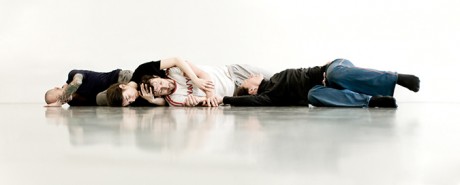Tabernacle


Photo Gallery
- Photographer Jonathan Mitchell
- Photographer Jonathan Mitchell
- Photographer Jonathan Mitchell
- Photographer Jonathan Mitchell
- Photographer Jonathan Mitchell
- Photographer Jonathan Mitchell
- Photographer Jonathan Mitchell
- Photographer Jonathan Mitchell
- Photographer Jonathan Mitchell
- Photographer Jonathan Mitchell
- Photographer Jonathan Mitchell
- Photographer Jonathan Mitchell
- Mikel Mat – photographer Pari Naderi
- Mat Mikel 90 – photographer Pari Naderi
- Mat deposition – photographer Pari Naderi
- Elena group – photographer Pari Naderi
- Elena deposition – photographer Pari Naderi
- Cover eyes – photographer Pari Naderi
Faithful? Devoted? Pure? Can we still shelter in God’s house? Tabernacle is a new choreography about the Catholic Church and the making of the Irish body. Tabernacle investigates authority, control and the individual search for purposeful living.
Premiered Project Arts Centre, Dublin as part of the 2011 Dublin Dance Festival
Calmly conceived and intellectually robust, [Ó Conchúir’s artistic] strategy doesn’t just produce eloquent movement, it creates powerful art. Michael Seaver, The Irish Times
Read Article
This is the most amazing show this year in the Dublin Dance Festival Audience member
But, towering over all for intensity was Tabernacle , the final show of the festival in which choreographer Fearghus Ó Conchúir bravely steps into the minefield of the Irish body and its bruising and confusing encounters with the power of Catholic Church….this work will surely merit a wider audience.
Seona Mac Reamoinn, The Irish Times Read review
Tabernacle is a striking artistic and symbolic response to a difficult contemporary issue, and delivered a strong emotional impact. Seona Mac Réamoinn, Irish Theatre Magazine, Read review
Tabernacle doesn’t extol or confront an audience with definitive concepts on the Catholc Church, but it refuses to shy away from it either. It’s a intricate balacing act that O’Conchúir has executed superbly, and more to the point, in a subtle and probing manner. This performance captures the process of how religion as a wider thematic structure provides a basis for the composition of ideals; how the individual learns, explores, manipulates or takes solace within this structure and how this layering of social and personal memory is reflected in the body. Eims O’Reilly, My Project blog Read Review
Choreographer Fearghus Ó Conchúir in collaboration with the performers
Composer Iarla Ó Lionáird
Visual artist Sarah Browne
Lighting Designer Sinéad Wallace
Performers Mikel Aristegui, Elena Giannotti, Stéphane Hisler, Bernadette Iglich, Matthew Morris
Production Manager Kevin Smith
Stage Manager Miriam Duffy
Assistant to the Choreographer Katrin Neue
Tabernacle is produced by Fearghus Ó Conchúir in association with Project Arts Centre, with the support of the Arts Council of Ireland, modul-dance, Dance Ireland and with funds from Dublin Dance Festival’s 2011 Co-production Initiative. Tabernacle was developed as part of modul-dance at The Place and Arts Station Poznan.
View Appendix, a printed artwork by Sarah Browne produced to accompany Tabernacle
Tabernacle grows out of an investigation I started in Mo Mhórchoir Féin, a film for RTÉ’s Dance on the Box series.
Having started formal dance training only in my twenties, I’m aware that it is sports and religion that contributed most to my physical and aesthetic formation before that. It was in church that I learnt the choreography of control, of symmetry, of awe, of spirituality. As congregation or as altar boy, I knew when to stand, when to kneel, when to offer my tongue or beat my breast. As a budding performer, I also learnt how to deliver that movement with grace, precision and reverence.
Some time later, my relationship to the Church has changed. Social and economic development in Ireland had already weakened the very precise control over personal and social choreography that the Catholic Church had exercised. The discovery of the Church’s complicity in the abuse of young Irish bodies weakened its remaining moral authority. And yet, the Church continues to play a significant role in the life of the country, even for those who no longer acknowledge its authority.
Visiting churches as we looked for locations for Mo Mhórchoir Féin, I was struck by the numbers of Eastern European men praying there, the African families, the Filipina young women and their older Irish counterparts. I was struck by the number of people who looked like they had nowhere else to go using the church building as a place of sanctuary and shelter. I heard stories of young junkies who came in to hold spoons over the votive candles. The church still manages to be a place where contemporary Ireland can be investigated and where the relationship between the contemporary and the traditional can be given form.
Because I want in this choreography to model a way of organising ourselves that is more thoughtful, more open, more fruitfully challenging, it is important to me that Tabernacle is made in a way that allows into it many different voices and experiences. Some of that input comes from contributors like Iarla Ó Lionáird whose music creates a rich and emotional sound world for the performance to inhabit, and from Sarah Browne whose practice as an artist engages with and reshapes the idea of economy as the dominant metaphor in contemporary social and political relations. The five performers in Tabernacle are creators in their own right and bring their own considerable ability and knowledge to the work, having danced with companies including DV8, Sasha Waltz, Pina Bausch, Rosemary Butcher, Felix Ruckert, Siobhan Davies, and Fabulous Beast. And finally the creation of the work is also influenced by people across Ireland, in Poznan, in Cyprus and in London where I will be workshopping in residencies and research phases the ideas and dance material that shape the piece. You can follow this process and contribute to it on my blog or on facebook.
